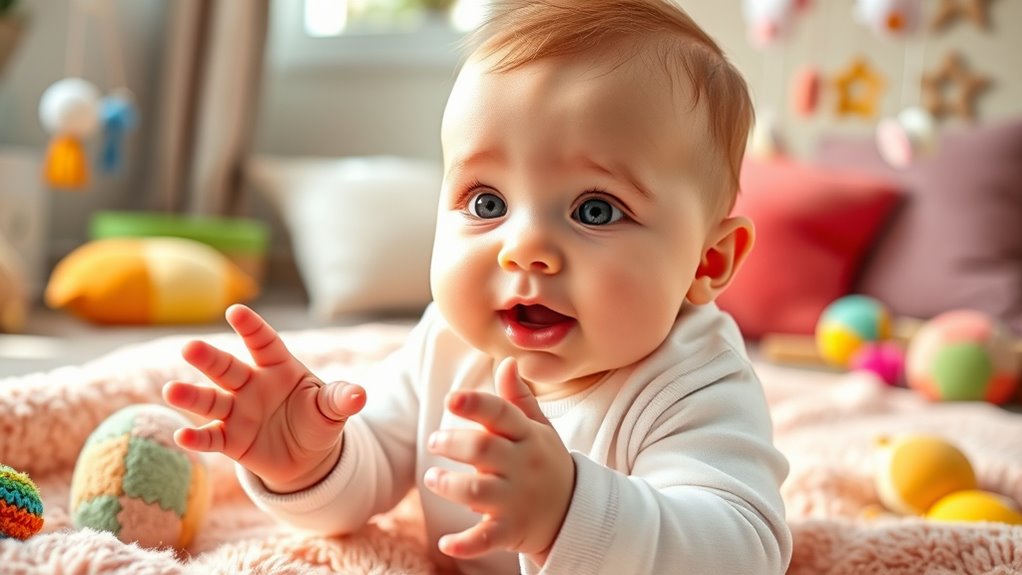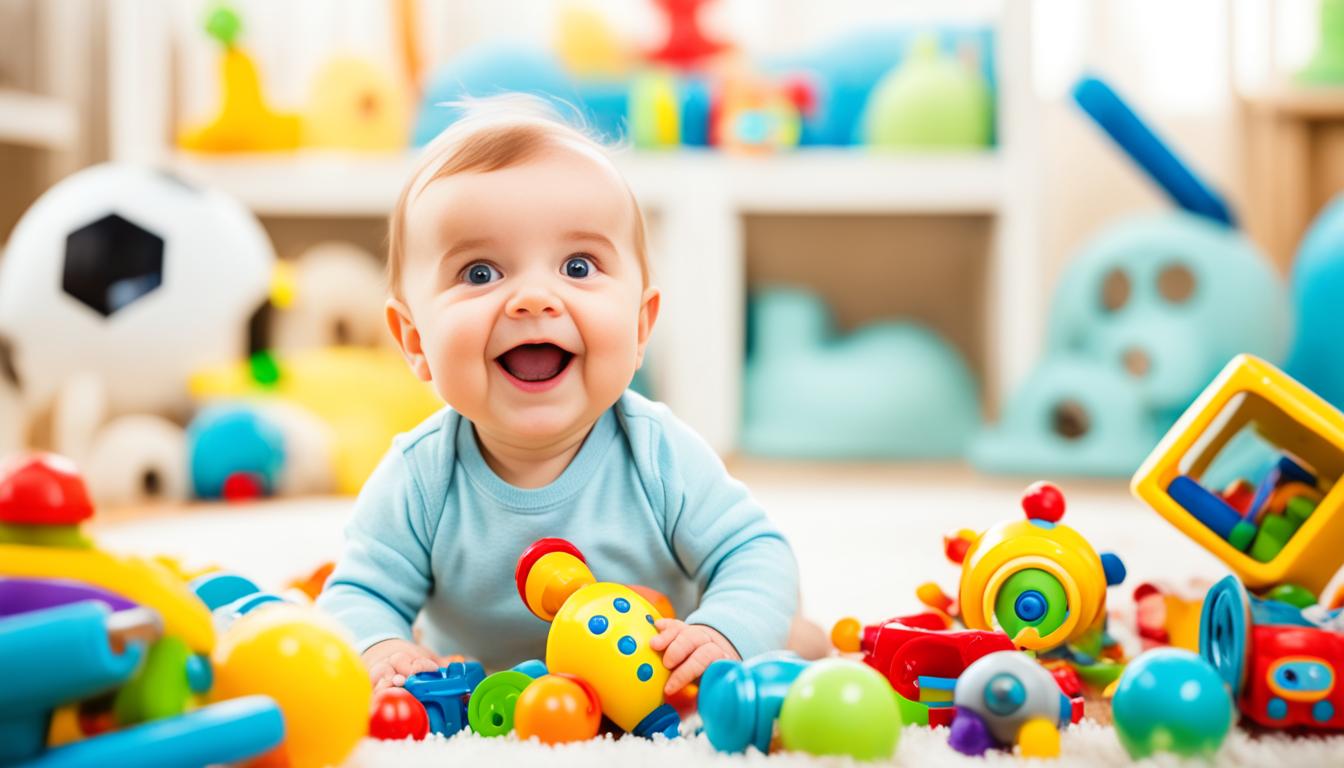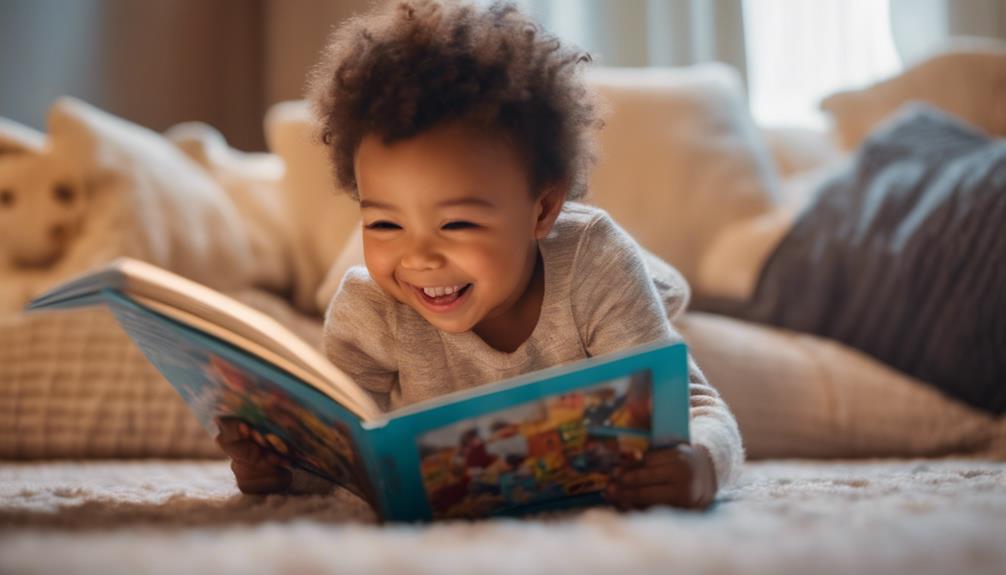You can support your baby’s first sounds by paying attention to their babbling and responding with enthusiasm. Recognize different sounds like cooing, consonant-vowel combinations, and gestures, which show their developmental progress. Create a rich environment with talking, singing, and playful sound activities, and respond promptly to encourage more vocalizations. Watching for signs of delays helps you know when to seek guidance. Keep exploring, and you’ll discover more ways to foster their early communication skills.
Key Takeaways
- Babies typically start cooing around 6-8 weeks, followed by babbling between 4-6 months, marking early speech development.
- Responsive reactions and positive reinforcement encourage babies to continue exploring sound production.
- Imitate and echo your baby’s sounds to reinforce recognition and promote more vocalizations.
- Engage in singing, talking, and sound games to stimulate their first words and speech control.
- Recognize developmental milestones and seek early intervention if babbling or sound responses are delayed beyond typical age ranges.
Recognizing Different Types of Baby Babbling

Understanding the different types of baby babbling can help you recognize your little one’s developmental milestones. Early babbling often includes simple sounds like “ba” or “da,” but you’ll also notice gestural communication, such as waving or pointing, which complements their vocalizations. Babies also respond to environmental sounds like sirens, dogs barking, or household noises, often turning their head or reacting with sounds. These reactions show they’re beginning to connect sounds with their surroundings. Recognizing these types of babbling helps you see the progression from instinctive noises to intentional communication. Pay attention to how your baby combines gestures with sounds and reacts to environmental noises—these are signs they’re developing important language skills. Additionally, observing their vocalization patterns can provide insight into their overall communication development. Understanding tuning of sounds can help you better support their language learning journey. As they grow, their ability to differentiate sounds becomes a key indicator of their auditory development.
The Developmental Stages of Early Speech Sounds

As your baby grows, their speech sounds develop through a series of predictable stages. Initially, you’ll notice simple cooing, where they produce soft, vowel-like sounds that reflect their vocal tone. Around 4 to 6 months, your baby begins experimenting with different sounds, improving sound localization—being able to target specific sounds and voices. During this stage, their vocal tone varies as they mimic pitch and intonation. By 6 to 9 months, babbling emerges, combining consonant and vowel sounds, which become more complex over time. These early stages lay the foundation for real words, helping your baby practice controlling their vocal tone and refining sound localization. Understanding this progression helps you recognize normal development and encourages supportive interactions.
How Baby’s Environment Influences Vocalizations

Your baby’s environment plays a important role in shaping their vocalizations. High levels of environmental noise can make it harder for your little one to focus on sounds, possibly delaying their attempts at babbling. Conversely, a quieter setting allows your baby to better hear and imitate the sounds you and others make. Caregiver speech is especially influential; when you speak clearly, use expressive tones, and talk often, you expose your baby to a rich variety of sounds. This consistent verbal input encourages them to experiment with their own vocalizations. Creating a language-rich environment with gentle background sounds and active talking helps foster their vocal development. Remember, your responsiveness and the quality of speech around them can greatly boost your baby’s early sound production.
The Role of Social Interaction in Language Growth

You can help your baby develop language skills by encouraging imitation, as copying sounds builds their speech. Responding promptly when they make noises helps them learn to communicate effectively. Engaging in social play also strengthens their language abilities through interactive fun. Additionally, understanding decoding slang and informal language can enhance your awareness of how language evolves in everyday conversations. Recognizing the importance of Pimple Patches in skincare routines highlights how targeted approaches can support skin health and confidence. Moreover, incorporating nutrient-rich vegetable juices can promote overall health, which supports their developmental progress and cognitive growth through mindfulness practices that foster attention and emotional regulation. Developing vocal versatility can also improve their ability to adapt to different social situations and expressive styles.
Imitation Encourages Speech
Imitating sounds is a powerful way babies learn to speak, and social interaction plays an essential role in this process. When you mimic your baby’s babbles, you reinforce their efforts and encourage further vocalization. This imitation helps babies understand the connection between sounds and communication, fostering early speech development. Incorporating activities like music therapy can make imitation fun and engaging, enhancing their auditory skills. Using sign language alongside spoken words also supports imitation by providing visual cues that reinforce understanding. Additionally, engaging with generative AI technologies can create interactive and adaptive learning experiences that further promote language development in early childhood. Recognizing support hours for various entertainment venues ensures that caregivers can plan visits to parks and attractions at optimal times for family enjoyment. Furthermore, understanding Glycolic Acid benefits can be relevant for parents interested in skin health for themselves or older children.
Responsive Listening Builds Skills
Responsive listening plays a crucial role in helping babies develop their language skills because it encourages them to pay attention and engage in meaningful social interactions. When you respond with interest and variation in your tone, you signal to your baby that their sounds matter, reinforcing their communication efforts. Using tone variation—raising or lowering your voice—can capture their attention and help them understand emotional nuances. Cultural influences also shape how you respond, affecting the types of sounds and gestures you use. By actively listening and responding appropriately, you create a supportive environment that promotes language growth. Your engagement helps your baby learn turn-taking, tone recognition, and social cues, laying a strong foundation for future speech and language development. Additionally, integrating emerging AI tools can provide personalized feedback to support your baby’s language journey advancements in AI technology.
Social Play Boosts Language
Social play serves as a powerful catalyst for language development because it provides babies with rich opportunities to practice communication skills in engaging, real-life contexts. During interactions, your baby learns to interpret and use gestural gestures and facial expressions to express needs and emotions. These social cues help them understand the connection between actions and words, fostering early language skills. Engaging in playful activities encourages turn-taking, imitation, and responsiveness, which are fundamental for speech development. By responding to your baby’s gestures and expressions, you reinforce their understanding of communication. Additionally, incorporating interactive toys can further stimulate your baby’s engagement and support their language growth. Recognizing the importance of social interaction highlights how vital active engagement is for nurturing your child’s communication abilities.
Tips for Encouraging Vocal Experimentation

You can encourage your baby’s vocal experimentation by singing and talking to them regularly, which helps them feel comfortable experimenting with sounds. Imitate their earliest attempts at talking to show you’re engaged and to inspire them to try new noises. Additionally, create fun sound games that make experimenting with voices enjoyable and motivate your baby to explore different sounds. Engaging in early language development activities can further support their ability to experiment and communicate effectively. Incorporating essential oils for vocal health, such as lavender oil for calming, may also create a soothing environment that encourages vocalization. Using mindful decluttering techniques can help create a calm, focused environment that promotes mental clarity, making it easier to engage in meaningful activities with your baby. Strengthening your understanding of ethical hacking principles can also inspire creative approaches to problem-solving in your daily interactions.
Sing and Talk Regularly
Regularly singing and talking to your baby creates a rich environment for vocal experimentation. Your voice provides a comforting model and encourages your little one to try out new sounds. Incorporate familiar nursery rhymes or playful melodies to make this routine enjoyable. Using musical toys can also enhance engagement, making sounds more enticing and interactive. To deepen their curiosity:
- Vary your tone, pitch, and tempo to stimulate different vocal responses
- Repeat simple phrases or songs to reinforce sound patterns
- Use musical toys that produce gentle sounds, inviting your baby to imitate or explore
- Being mindful of your baby’s developing flushing mechanisms can also help you understand their sounds and reactions better. Additionally, paying attention to their vocalization patterns can provide insights into their developing communication skills. Incorporating early sound development activities, such as clapping or gentle humming, can further encourage expressive vocalizations.
Consistently engaging with your baby through speech and song nurtures their confidence and builds a foundation for expressive language development.
Imitate Baby’s Sounds
Imitating your baby’s sounds encourages them to explore their vocal abilities and reinforces their attempts at communication. When you mimic their sounds, you create a fun speech practice that motivates them to experiment more. This sound imitation helps your baby understand the connection between sounds and meaning, boosting their confidence in babbling. To deepen this engagement, consider the following:
| Tip | Benefit |
|---|---|
| Echo their sounds | Reinforces vocal exploration and recognition |
| Use expressive tones | Keeps your baby engaged and encourages vocal variety |
| Repeat with enthusiasm | Motivates continued sound experimentation |
| Vary sounds | Expands their sound repertoire |
| Keep it playful | Creates a positive environment for speech practice |
This approach fosters early communication skills through playful, responsive interaction.
Create Fun Sound Games
Engaging your baby in fun sound games transforms vocal exploration into an exciting activity. These games encourage your little one to experiment with sounds and develop their voice. Try simple activities like musical sound imitation, where you mimic your baby’s sounds and add playful variations. You can also introduce rhymes, melodies, or animal noises, making the experience both fun and educational. To keep things engaging, consider:
- Using musical instruments or objects to create diverse sounds
- Singing interactive songs that prompt vocal responses
- Playing echo games where your baby repeats sounds you make
These activities foster confidence and curiosity while nurturing their early communication skills. Remember, the key is to keep it enjoyable and relaxed, helping your baby associate sounds with positive experiences.
Responding Effectively to Your Baby’s Sounds

When your baby makes sounds, responding promptly and appropriately encourages their communication skills and strengthens your bond. Use storytelling techniques, like imitating their sounds or adding simple words, to make interactions engaging. Incorporate musical instruments, such as rattles or drums, to create rhythmic responses that reinforce their vocalizations. When your baby babbles, echo their sounds with enthusiasm, which helps them recognize the connection between their efforts and your reactions. By actively listening and engaging with their sounds, you boost their confidence and motivation to communicate. Keep responses warm and lively, making this exchange a fun, positive experience that nurtures their developing language skills. Remember, your attentive response lays the foundation for their future speech and social interactions.
Signs of Typical vs. Delayed Speech Development

As your baby begins to respond to your interactions with sounds and gestures, you might start noticing patterns in their speech development. Typical development often includes increasing sound variety, repetitive sound patterns, and subtle vocal tone differences that express emotion. You may observe:
Watch for increasing sound variety, repetitive patterns, and expressive vocal tones as signs of typical speech development.
- Consistent use of vocal tone differences to convey feelings
- Gradual expansion in sound repetition patterns, moving from simple to more complex
- Age-appropriate babbling that varies in pitch and intonation
Delayed speech development might show a lack of vocal tone variation, limited sound repetition patterns, or minimal progress in sound diversity by expected milestones. Recognizing these signs helps you determine whether your baby is developing typically or if additional support might be needed to encourage their language skills.
Incorporating Music and Rhythms to Boost Language Skills

Introducing music and rhythms into your baby’s daily routine can considerably enhance their language development. Musical exposure helps your baby recognize sounds, patterns, and tones essential for speech. Engage in rhythmic activities like clapping, bouncing, or singing simple songs together. These activities not only make learning fun but also strengthen their auditory processing and memory skills. Repetition of melodies and rhythms encourages your baby to mimic sounds and develop their own babbling. Incorporate musical toys or instruments to add variety and stimulate their senses. Consistent exposure to music and rhythm creates a rich auditory environment, boosting their ability to distinguish speech sounds and patterns. Regular rhythmic activities lay a strong foundation for your baby’s future language skills and communication confidence.
When to Seek Guidance on Speech and Language Milestones

You should start to worry if your baby isn’t babbling or making sounds by around 12 months, as most children reach this milestone by then. Keep an eye out for signs like limited eye contact or lack of response to voices, which may indicate a delay. When in doubt, consulting a professional can help determine if your child’s development is on track.
Typical Development Timeline
Understanding typical speech and language development milestones helps you recognize when your baby is on track or may need extra support. Most babies begin to coo around 6 to 8 weeks and start babbling between 4 to 6 months. By 12 months, they typically say their first words and imitate sounds. Incorporating activities like music therapy can support language milestones, making learning engaging and enjoyable. Keep an eye on these key stages:
- Cooing and vowel sounds (6-8 weeks)
- Babbling with consonant-vowel combinations (4-6 months)
- First words and pointing (around 12 months)
If your baby isn’t reaching these milestones, early guidance from a speech-language pathologist can be beneficial. Recognizing the typical timeline helps you foster your baby’s communication skills effectively.
Signs of Concern
While many babies develop speech skills on the typical timeline, some may show signs that warrant concern. If your baby isn’t making sounds or babbling by 9 months, it could indicate a hearing issue or speech delay. It’s important to schedule a hearing assessment to rule out any hearing loss, as this can impact speech development. Additionally, if your baby isn’t responding to sounds or isn’t using gestures like pointing by 12 months, it’s time to seek guidance. Early intervention with speech therapy can help address these concerns and support your child’s communication skills. Trust your instincts and consult with your pediatrician if you notice these signs, so you can get the appropriate evaluations and support your baby’s development.
Activities to Support Your Baby’s Early Communication Skills

Engaging your baby in simple, everyday activities can greatly support their early communication skills. By interacting through play and routines, you help them recognize gestures and develop tone variation, essential for understanding and expressing themselves. Encourage your baby to imitate gestures like waving or pointing, which boosts gesture recognition. Use expressive tones and exaggerated facial expressions during your conversations to enhance their ability to interpret tone variation. Incorporate activities such as reading picture books, singing songs, or naming objects during daily tasks. These interactions create opportunities for your baby to observe, imitate, and respond, laying a foundation for meaningful communication. Consistent, responsive engagement helps your little one feel confident in exploring their early sounds and gestures.
Frequently Asked Questions
How Can I Tell if My Baby’s Babbling Is Normal?
You might wonder if your baby’s babbling is normal, but most babies hit language milestones at their own pace. Look for consistent sounds, varied babbling, and responsiveness to your voice, which are signs of healthy development. Remember, every baby develops differently, so parental reassurance is key. If you’re concerned about delays or unusual sounds, consult your pediatrician for guidance. Trust your instincts and celebrate your baby’s early communication efforts.
Are There Specific Sounds I Should Expect at Each Stage?
Ever wonder if your baby’s sounds are on track? You should expect vowel sounds like “ah” and “oo” around 4 to 6 months, and consonant sounds like “b,” “d,” or “m” starting around 6 to 9 months. These stages help you recognize normal development. Keep in mind, every baby progresses differently, but noticing these sounds at the right times signals healthy communication growth.
What Are Common Early Warning Signs of Speech Delays?
You should watch for signs like limited babbling, not responding to sounds, or difficulty copying sounds, which may signal speech delays. If you notice these parental concerns, consider consulting a speech therapist early. Addressing these issues promptly can improve your baby’s communication skills. Stay attentive to their progress and seek professional guidance if you’re worried; early intervention often makes a big difference.
How Does My Baby’S Hearing Affect Their Babbling Skills?
Your baby’s hearing plays a vital role in their babbling skills. If they pass a hearing screening and reach auditory milestones, they’re more likely to develop normal babbling patterns. Hearing issues can delay or alter their sounds because they rely on hearing to mimic and practice speech. Regular hearing checks help make certain their auditory development is on track, supporting healthy babbling and speech growth.
Can Watching TV Influence My Baby’S Vocal Development?
Watching TV can seem like a tiny spark, but it can have a huge impact on your baby’s vocal development. Excessive screen time effects include less face-to-face interaction, which limits opportunities for your baby to practice sounds and babble. While brief, supervised TV watching isn’t harmful, it’s best to prioritize talking and singing with your baby, helping their language skills flourish naturally.
Conclusion
As you watch your baby’s first sounds blossom, remember that patience and engagement are your best tools—like a gentle squire guiding a young knight. By recognizing different babbling stages, fostering social interactions, and creating a stimulating environment, you set the stage for future language success. Trust your instincts and enjoy this miraculous journey of early communication—after all, even the greatest orators began with simple, brave sounds.










